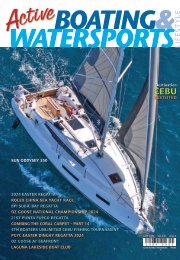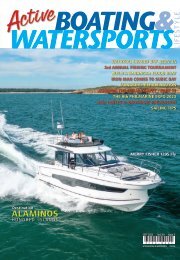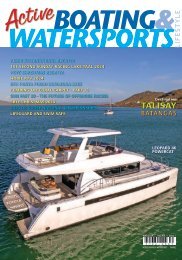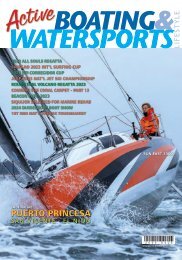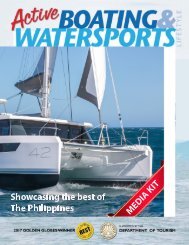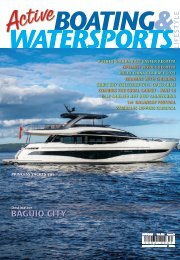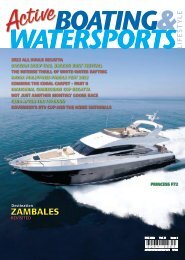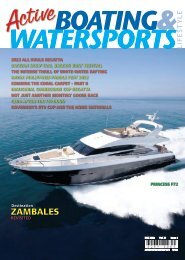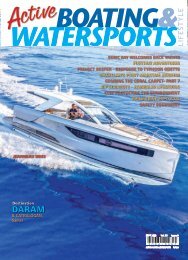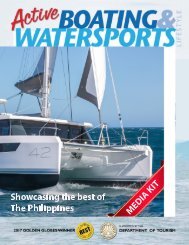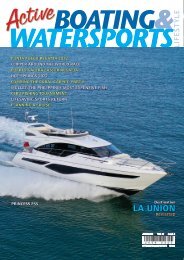Create successful ePaper yourself
Turn your PDF publications into a flip-book with our unique Google optimized e-Paper software.
Yacht Club was founded, and the rivalry between the two clubs<br />
resulted in the founding of the America’s Cup in 1820. This<br />
prestigious event probably did more to improve the design and<br />
performance of sailing yachts than anything else, as designers,<br />
boat-builders and yachtsmen fought to produce the best<br />
and fastest boat with ever improving<br />
technology and skill.<br />
At the same time that yachting was<br />
growing in renown through the<br />
prestigious racing events, A small band<br />
of individuals eschewed competition<br />
and sailed simply to improve their<br />
mastery of a small boat in the open<br />
water. The first to leave any real<br />
record of his exploits was Richard<br />
Turrill McMullen in the 1850s, when<br />
McMullen was sailing, yachting was<br />
still in the province of gentleman skipper, with a hired crew<br />
of professional sailors, so McMullen set out to prove that a<br />
gentleman skipper could actually handle the boat himself. He<br />
learned the hard way –through experience and practical sailing.<br />
to other members. In 1902 the club received its royal warrant<br />
and appeared under the name by which it is now known, the<br />
Royal Cruising Club. Five years later the Cruising Association<br />
was formed with the object of providing more information<br />
about harbours and ports, and encouraging safe and seaman<br />
like cruising. The first book to<br />
be devoted entirely to the art of<br />
Unlike the boats of<br />
private racing events,<br />
such as the Americas<br />
Cup, they were<br />
skippered and sailed<br />
amateur yachtsmen.<br />
Folkboat<br />
cruising – now regarded as a classic<br />
– was Claud Worth’s Yacht Cruising,<br />
published in 1910. He explained the<br />
many branches of expertise which<br />
were required by the all-round<br />
seaman and handler of small craft.<br />
After the early pioneering of<br />
McMullen, Worth and a few other<br />
English eccentrics, cruising grew<br />
rapidly in popularity and spread<br />
to the United States, where the cruising club of America was<br />
founded in 1922. Although the early cruising boats were all<br />
converted working boats, a Norwegian naval architect, Colin<br />
Archer, had turned his attention to designing craft specifically<br />
for cruising. A lifetime spent amongst the difficult sailing<br />
waters of Norway made him well qualified to produce sturdy,<br />
seaworthy boats.<br />
McMullen did a great deal to prove that a small craft is no<br />
less safe and seaworthy than a large one, if properly handled;<br />
and he revealed the as-then unrecognized truth that it is the<br />
shore which is the danger for sailing craft not the open sea.<br />
McMullen died of a heart attack at the helm of his yacht<br />
Perseus in 1891 – just four years before another equally<br />
famous Yachtsman, Captain Joshua Slocum, a Canadian,<br />
completed the first single-handed circumnavigation of the<br />
world in his boat, Spray. The idea of rounding the horn in<br />
a boat less than 40ft in length was regarded at the time as<br />
suicidal. What made the achievement particularly spectacular<br />
was the fact the he sailed around the world against prevailing<br />
winds. In fact, the next circumnavigation in a small boat was<br />
not made for another 25 years and when it was, the route<br />
was via the Panama canal, thus avoiding the rigors of the<br />
Southern Atlantic and Cape Horn in particular.<br />
A little earlier in 1880, the first cruising club had been<br />
formed in Britain, the object of which was to promote<br />
good seamanship, navigation and pilotage. Members were<br />
encouraged to explore the less know coasts and harbours, and<br />
produce pilot information on them which could be disseminated<br />
84<br />
Although there was still a deep schism between cruising and<br />
racing sailors in the early 20th century, the founding of the first<br />
public offshore race, the Fastnet in 1925, did much to marry the<br />
two branches of the sport. The boats which took part in the first<br />
Fastnet race were, in the main, converted working boats, like<br />
the winner Jolie Brise a converted pilot boat. Unlike the boats<br />
of private racing events, such as the Americas Cup, they were<br />
skippered and sailed amateur yachtsmen. A new club came into<br />
being, The Royal Ocean Racing Club, and with it a new breed of<br />
boats, the cruiser-racers.<br />
Modern advances in boat technology owe a great deal to the<br />
development of this form of racing, and, although there is still<br />
a great difference between sailors whose prime objective is to<br />
compete and those whose main purpose is to cruise, there is<br />
often less of a distinction between the types of boat.Thanks<br />
to the new breed of boats, which are safe, speedy and easily<br />
maintained, cruising today far from being the pastime of a<br />
few eccentrics, has become one of the most popular sailing<br />
activities. Competing with the elements, discovering new<br />
coastlines and getting away from the pressures of the industrial<br />
rat-race – these advantages have persuaded large numbers of<br />
people to try their hand at cruising.<br />
You can buy a boat suited to your need for pottering, or you<br />
can occasionally try your hand at racing. You are master of<br />
your own boat, reliant on your own skills for safety, and you<br />
can travel where you will, at a speed determined by yourself.<br />
your boat and the elements. Small wonder, therefore, in an<br />
age where the individual has less and less control over his own<br />
destiny, that cruising has become one of the fastest growing<br />
sports since the Second World War.




